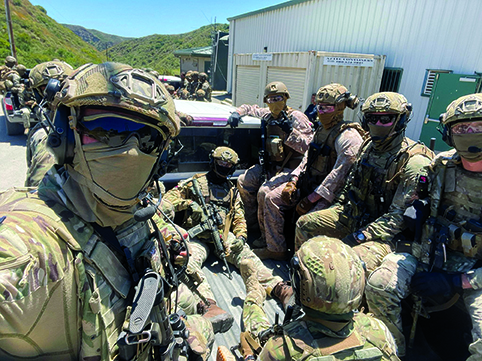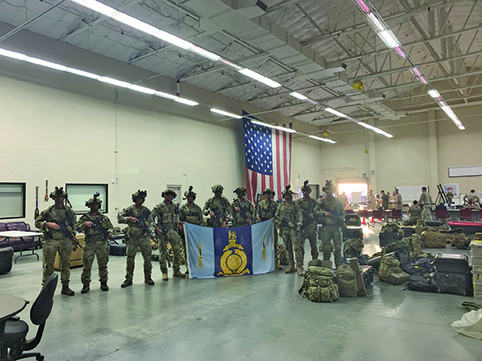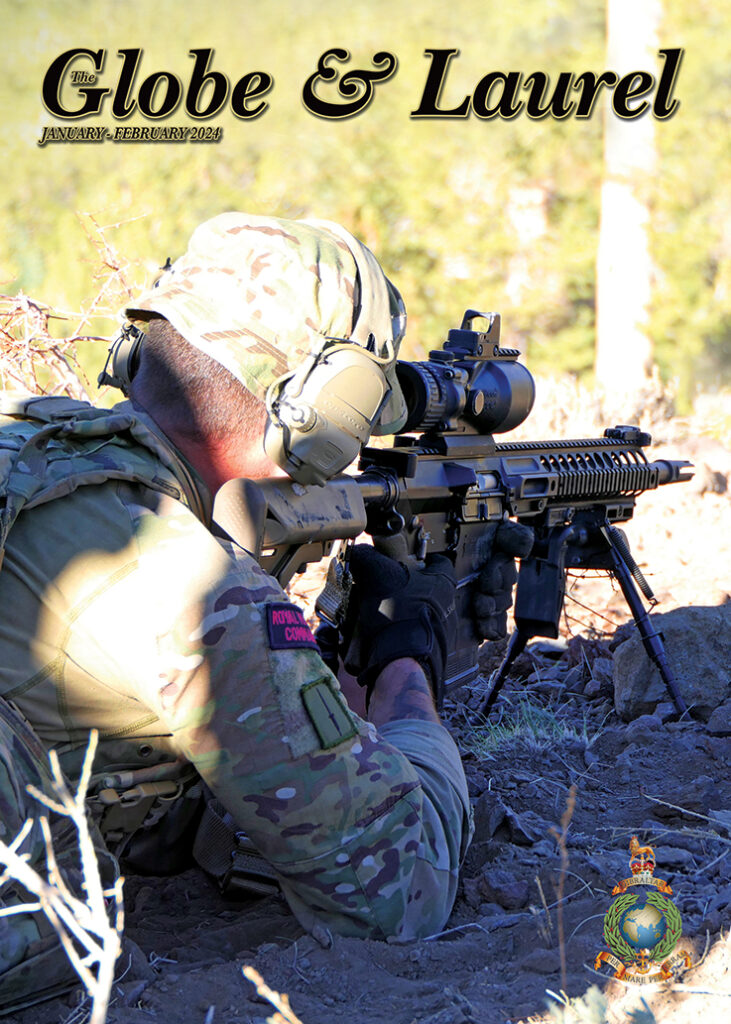The following article is taken from the latest issue of the Globe & Laurel magazine.
Click the button below to discover more.

Eleven Royal Marines from B Coy and another from 29 Cdo Regt RA departed Norton Manor Camp for the beginning of Chosin 23.1. This was the second iteration of the Chosin series, integrating this time with the USMC’s 15th Marine Expeditionary Unit (15 MEU) whilst attached to B Coy 1st Recon, based out of Camp Pendleton in sunny California.
The aim for the deployment was simple: to improve interoperability between the USMC and Royal Marines; identify problems and solutions and then provide feedback to the Coy and wider UKCF. This would demonstrate the flexibility of the Cdo Force and its ability to integrate seamlessly, on any scale, should it be required on operations in the future. The deployment gave us an excellent opportunity to develop relations between the Royal Marines and the USMC, not only through shared high standards in work, but also by sharing our Commando sense of humour with them. Trying to help them wrap their heads around what words like ‘hoofing’ and ‘gopping’ meant was an important task, as they would be hearing terms like these frequently for the next six months of their lives!
One of the first memorable interactions with our Recon counterparts came early in the deployment, after a questionably supportive celebration of 4 July.

We started our training with Expeditionary Operations Training Group (EOTG), which is essentially T-Wing for the MEU. During the Close Quarters Tactics-Enablers (CQTE) package they took us back to basics on the ranges, going from kit set up and weapon hold positions, building up to more advanced firing like the competition shoot ‘El Presidente’ and engaging close range targets on the move. This training package lasted for two weeks, and as well as spending a lot of time firing live with their never-ending allocation of ammunition, there was also significant medical training and urban movement. EOTG were quick to notice our keen and willing-to-learn attitude, picking up skills and drills quickly, which allowed the team to build a solid relationship with the instructors, and opened doors for other opportunities. The first of these opportunities arrived soon after the course, when one of the lead EOTG instructors invited the team to a private tour of the Oakley Headquarters, organised through a close friend of his, and we received 70% discount in the factory store. A key highlight of the tour was the laser demonstration: this showed us the effect different lenses have on a shooter’s eye, which in turn can have a dramatic effect on a shooter’s ability to identify targets and engage them efficiently. We cleaned out the shop on our way to the exit, ready to head into our first weeks of working hand-in-hand with Recon as a reconnaissance asset.
Our next training package was the Ground Interoperability course; our first engagement training alongside B Coy 1st Recon Marines. The course was again run by EOTG, issuing mission sets to the Coy Headquarters and letting them plan and execute as they saw fit. After two weeks of firing on the ranges and conducting raid-focused training, we were very keen to embed ourselves into a raid force and start kicking down doors, however once the FRAGO dropped, the team quickly learned it was going to be living in a bush and eating MREs.

Our first tasking and planning cycle led us to a split OP on the Camp Pendleton training area, a training area much larger (and significantly less wet) than Sennybridge; large enough to be considered a national park back in the UK. We settled into the routine well and provided detailed reporting back to HQ as required. Taking a bearing and yomping in that direction was unsustainable whilst trying to bushwhack and climb through the density of vegetation, something that became a theme and continued towards the very end of the trip. This training package ended with multiple successful raids from Recon. With the USMC raid force being supported by intelligence gained from Team One in a reconnaissance role, 1st Recon developed an appreciation for Royal. The reports being sent in were invaluable and the team wasn’t scared of crossing difficult terrain to best position ourselves to achieve our mission.
You can read the concluding part to this article in the Jan/Feb 24 edition of the Globe & Laurel.
Read more from the Journal of the Royal Marines
For more information, and to read similar stories, visit:
Globe & Laurel – RMA – The Royal Marines Charity (rma-trmc.org)
